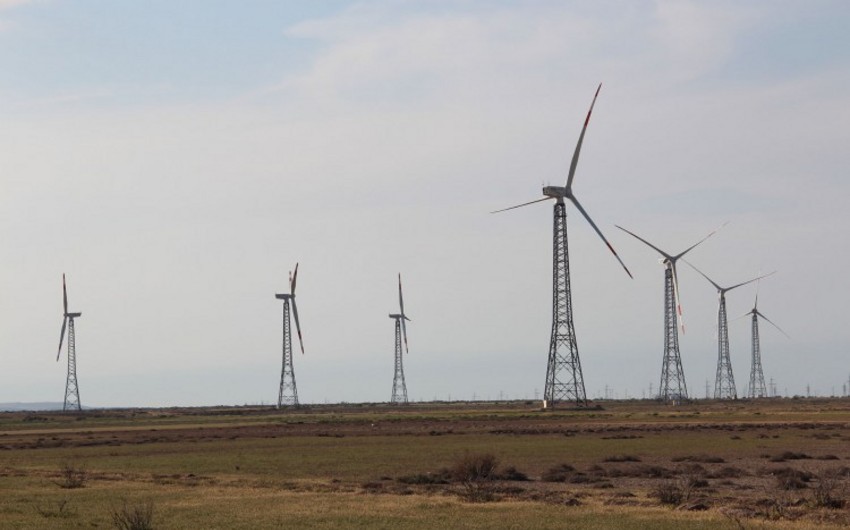Azerbaijan is set to make broader inroads into the European energy market by adding electricity supplies to fossil fuel exports.
The country’s President Ilham Aliyev signed a strategic agreement with Georgia, Hungary and Romania last week to leverage the national renewable energy resources to supply consumers in Europe.
The president said Azerbaijan owns sufficient green energy resources, giving it the ability to enter the European marketplace as a new electricity exporter.
“Azerbaijan’s renewable energy potential is more than 27 gigawatts of wind and solar power onshore and 157 gigawatts of wind power in the Azerbaijani sector of the Caspian Sea,” President Aliyev said during the signing ceremony of the agreement on December 17, President.Az reports.
“Together with one of our country’s strategic investors, we plan to implement 3 gigawatts of wind and one gigawatt of solar power by 2027, 80 percent of which will be exported. By 2037, we plan to create an additional capacity of at least 6 gigawatts," the president revealed.
He added that investments by two global energy operators in Azerbaijan’s green energy sector are going to create 22 gigawatts of energy, including wind and solar power. At least 3 gigawatts of additional transmission capacity is expected to be created for the first phase of Azerbaijani export.
Electricity supplies will open an all-new chapter in the energy cooperation between Azerbaijan and Europe, with the continent already receiving crude oil and natural gas from the Caspian Sea littoral state. In 2021, Azerbaijan's natural gas exports to the European Union market through the Southern Gas Corridor mega pipeline stood at 8.2 billion cubic meters (bcm), and this figure has risen to 11.3 bcm in 2022. Next year, it is expected to hit 11.6 bcm. The total natural gas export from Azerbaijan is projected to reach nearly 24 bcm or 5 bcm more in 2023 than in 2021.
Electricity export is a key part of Azerbaijani government’s green energy policy. The country’s authorities intend to increase the share of renewable energy sources in the country’s overall energy production to 30 percent by 2030. To make this happen, Azerbaijan has adopted the Law on the Use of Renewable Energy Sources (RES). Baku is currently developing a five-year RES strategy.
In January and March of this year, Saudi-based ACWA Power and UAE-based Masdar laid the foundation for 240-MW wind and 230-MW solar power plants, respectively, in Azerbaijan. Masdar’s plant will reportedly become operational in 2023 with an overall energy output of nearly half a billion kilowatt-hours of electricity per annum, which is enough to supply power to over 110,000 houses.
In the meantime, the Minister of Investments of Saudi Arabia and co-chairman of the joint commission between Baku and Riyadh, Khalid bin Abdulaziz al-Falih said the Saudi government intends to implement more energy projects in Azerbaijan and join the agreement signed recently by Azerbaijan, Georgia, Hungary, and Romania to export Azerbaijani electricity to Europe.
According to a report published by the German-Azerbaijani Chamber of Commerce, the potential contribution of wind power in Azerbaijan stands at 59.2 percent of overall renewable sources. The same publication cited solar power as the second-largest green energy source in the country, with a total of 8,000 MW potential. Biomass, geothermal, and hydropower (excluding large hydropower stations) were also cited as promising renewables at 900 MW, 800 MW, and 650 MW, respectively.
The Azerbaijani government also plans to transform the liberated Karabakh (Garabagh) and East Zangazur regions fully into a “Netto Zero Emission” Zone as a priority within the ongoing reconstruction and development projects, as well as reduce carbon dioxide emissions by 40 percent by 2050. The green energy potential of the liberated territories of Azerbaijan includes almost all types of renewable energy sources, including hydro, solar, wind, and geothermal.
At least four small hydroelectric power plants have been put into operation in the liberated lands so far, and five more with a capacity of 25-30 MW will be operational soon.
The Fuzuli, Jabrayil, and Zangilan districts come in at number two after the Nakhchivan Autonomous Republic in Azerbaijan for their rich solar power resources. The solar radiation per square meter in these regions is reportedly amounted to 1600-1700 kWh per year, while the total solar energy potential is estimated at 7,200 megawatts.
The wind energy potential of the liberated territories is especially prevalent in the Kalbajar and Lachin districts. According to data released by the Energy Ministry, the average annual wind speed in these territories reaches 10 meters per second. The potential of wind energy in the mountainous areas of the Karabakh region is estimated at 2,000 megawatts.
Meanwhile, there are also 4,000-5,000 cubic meters of thermal water per day in the territory of the Kalbajar, Lachin, and Shusha districts.
In May 2021, the Energy Ministry of Azerbaijan signed an agreement with the Japanese company TEPSCO to create a “green energy” zone in the territories of Azerbaijan liberated from Armenian occupation. The agreement sets out the concept and strategy for ensuring the effective use of the potential of such renewable energy sources as wind, solar, hydropower, geothermal energy, and bioenergy.







 The Mine Action Agency of Azerbaijan (ANAMA) reported on Thursday the discovery of a significant amount of explosives in the Khojavand district of ...
The Mine Action Agency of Azerbaijan (ANAMA) reported on Thursday the discovery of a significant amount of explosives in the Khojavand district of ...
 Iran has refuted reports of alleged damage to Shimon Peres Negev Nuclear Research Centre located southeast of Dimona, Israel, during the recent air...
Iran has refuted reports of alleged damage to Shimon Peres Negev Nuclear Research Centre located southeast of Dimona, Israel, during the recent air...
 Iran’s Foreign Minister, Hossein Amir-Abdollahian, has labeled a foiled Israeli drone attack in certain parts of the country as a "failure" for Isr...
Iran’s Foreign Minister, Hossein Amir-Abdollahian, has labeled a foiled Israeli drone attack in certain parts of the country as a "failure" for Isr...



